Paper Menu >>
Journal Menu >>
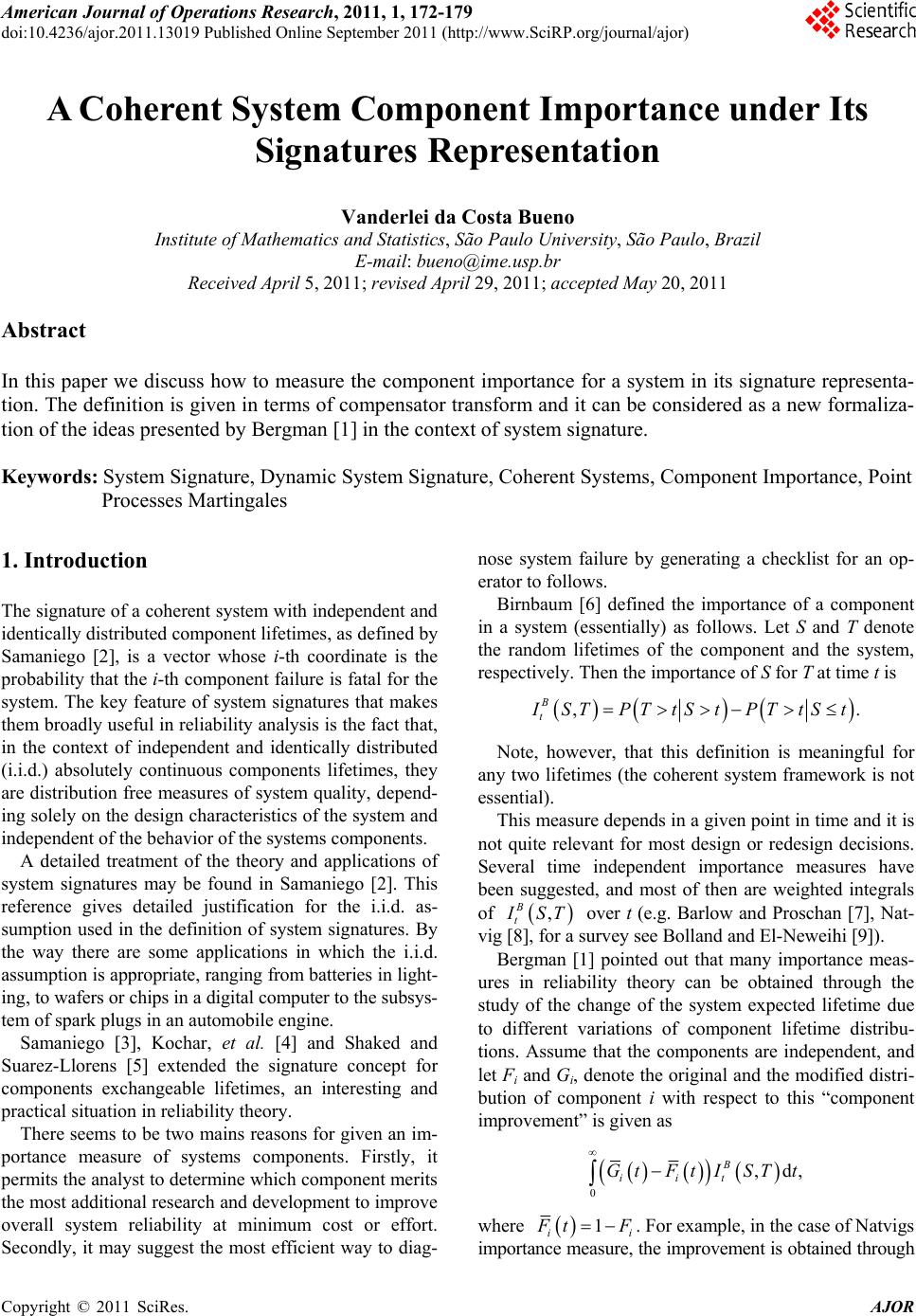 American Journal of Oper ations Research, 2011, 1, 172-179 doi:10.4236/ajor.2011.13019 Published Online September 2011 (http://www.SciRP.org/journal/ajor) Copyright © 2011 SciRes. AJOR A Coherent System Component Importance under Its Signatures Representation Vanderlei da Costa Bueno Institute of Mathematics and Sta tistics, São Paulo Universi ty , São Paulo, Brazil E-mail: bueno@ime.usp.br Received April 5, 2011; revised April 29, 2011; accepted May 20, 2011 Abstract In this paper we discuss how to measure the component importance for a system in its signature representa- tion. The definition is given in terms of compensator transform and it can be considered as a new formaliza- tion of the ideas presented by Bergman [1] in the context of system signature. Keywords: System Signature, Dynamic System Signature, Coherent Systems, Component Importance, Point Processes Martingales 1. Introduction The signature of a coherent system with independent and identically distributed component lifetimes, as defined by Samaniego [2], is a vector whose i-th coordinate is the probability that the i-th component failure is fatal for the system. The key feature of system signatures that makes them broadly useful in reliability analysis is the fact that, in the context of independent and identically distributed (i.i.d.) absolutely continuous components lifetimes, they are distribution free measures of system quality, depend- ing solely on the design characteristics of the system and independent of the behavior of the systems components. A detailed treatment of the theory and applications of system signatures may be found in Samaniego [2]. This reference gives detailed justification for the i.i.d. as- sumption used in the definition of system signatures. By the way there are some applications in which the i.i.d. assumption is appropriate, ranging from batteries in light- ing , to wafers or ch ips in a d igital co mputer to th e sub sys- tem of spark plugs in an automobile engine. Samaniego [3], Kochar, et al. [4] and Shaked and Suarez-Llorens [5] extended the signature concept for components exchangeable lifetimes, an interesting and practical situation in reliability theory. There seems to be two mains reasons for given an im- portance measure of systems components. Firstly, it permits the analyst to determine which component merits the most additional research and development to improve overall system reliability at minimum cost or effort. Secondly, it may suggest the most efficient way to diag- nose system failure by generating a checklist for an op- erator to follows. Birnbaum [6] defined the importance of a component in a system (essentially) as follows. Let S and T denote the random lifetimes of the component and the system, respectively. Then the importance of S for T at time t is ,. B t ISTPTtStPTtSt Note, however, that this definition is meaningful for any two lifetimes (the coherent system framework is not essential). This measure depends in a given point in time and it is not quite relevant for most design or redesign decisions. Several time independent importance measures have been suggested, and most of then are weighted integrals of , B t I ST over t (e.g. Barlow and Proschan [7], Nat- vig [8], for a su rvey see Bolland and El-Neweihi [9]). Bergman [1] pointed out that many importance meas- ures in reliability theory can be obtained through the study of the change of the system expected lifetime due to different variations of component lifetime distribu- tions. Assume that the components are independent, and let Fi and Gi, denote the original and the modified distri- bution of component i with respect to this “component improvement” is given as 0 ,d B iit GtFtISTt , where 1 ii F tF . For example, in the case of Natvigs importance measure, the improvement is obtained through 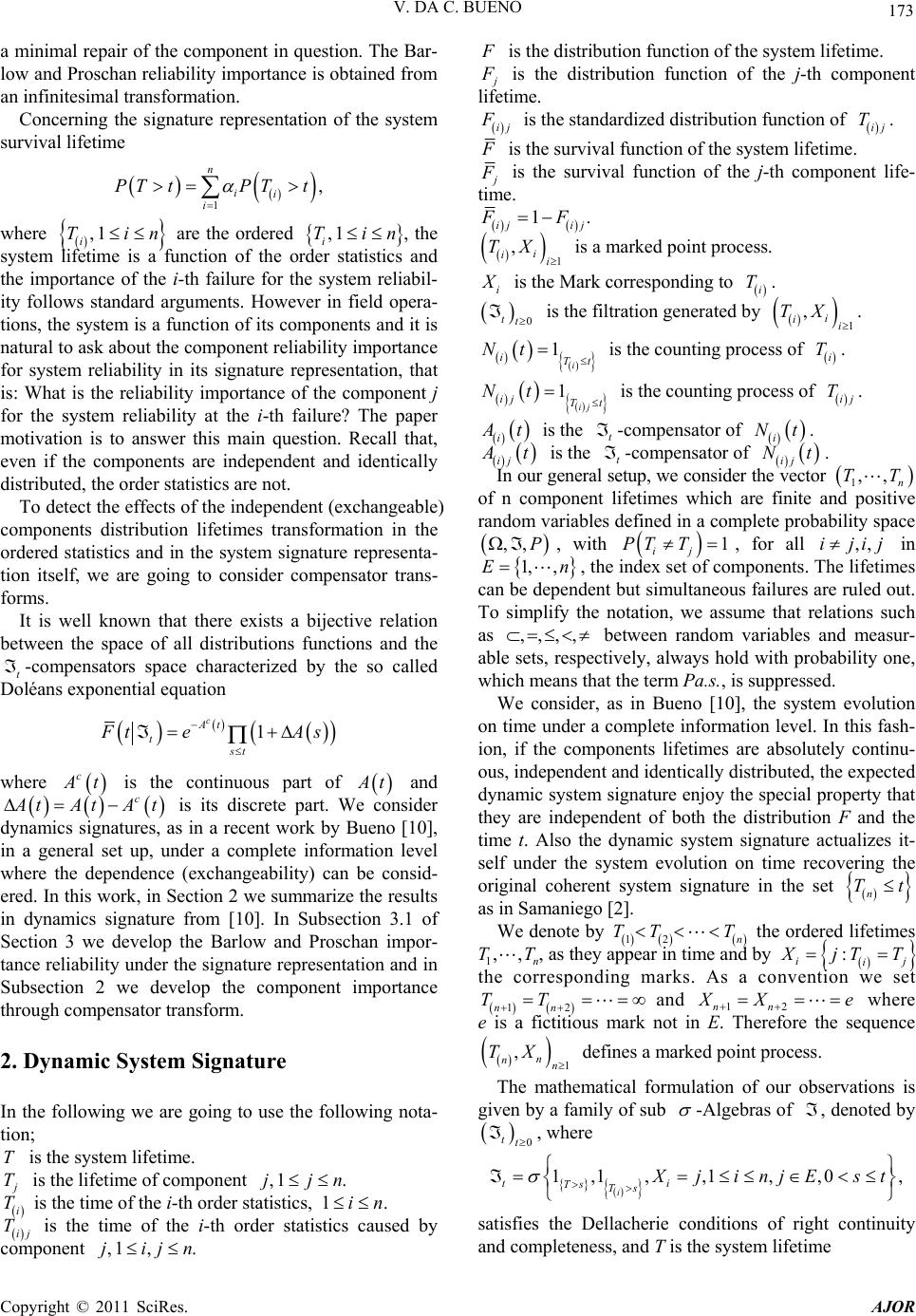 V. DA C. BUENO 173 nn a minimal repair of the component in question. The Bar- low and Proschan reliability importance is obtained from an infinitesimal transformation. Concerning the signature representation of the system survival lifetime 1, n ii i PT tPTt where are the ordered , the system lifetime is a function of the order statistics and the importance of the i-th failure for the system reliabil- ity follows standard arguments. However in field opera- tions, the system is a function of its components and it is natural to ask about the component reliability importance for system reliability in its signature representation, that is: What is the reliability importance of the component j for the system reliability at the i-th failure? The paper motivation is to answer this main question. Recall that, even if the components are independent and identically distributed, the order statistics are not. ,1 i Ti ,1 i Ti To detect the effects of the independent (exchangeable) components distribution lifetimes transformation in the ordered statistics and in the system signature representa- tion itself, we are going to consider compensator trans- forms. It is well known that there exists a bijective relation between the space of all distributions functions and the t-compensators space characterized by the so called Doléans exponential equation 1 c At tst F te As where c A t is the continuous part of A t and c A tAt At is its discrete part. We consider dynamics signatures, as in a recent work by Bueno [10], in a general set up, under a complete information level where the dependence (exchangeability) can be consid- ered. In this work, in Section 2 we summarize the results in dynamics signature from [10]. In Subsection 3.1 of Section 3 we develop the Barlow and Proschan impor- tance reliability under the signature representation and in Subsection 2 we develop the component importance through compensator transform. 2. Dynamic System Signature In the following we are going to use the following nota- tion; T is the system lifetime. j T T is the lifetime of component ,1 .jj 1n i T is the time of the i-th order statistics, . in ij is the time of the i-th order statistics caused by component ,1 ,.jijn F is the distribution function of the system lifetime. j F is the distribution function of the j-th component lifetime. ij F is the standardized distribution function of . ij T F is the survival function of the system lifetime. j F is the survival function of the j-th component life- time. 1. ij ij F F 1 ,i ii TX is a marked point process. i X is the Mark corresponding to . i T 0 tt is the filtration generated by . 1 ,i ii TX 1i iTt Nt is the counting process of . i T 1ij ij Tt Nt is the counting process of . ij T i A t is the t -compensa tor of . i Nt ij A t is the t -compensa tor of ij Nt. In our general setup, we consider the vector 1,, n TT of n component lifetimes which are finite and positive random variables defined in a complete probability space ,,P , with 1 ij PT T , for all ,,ijij in ,,, 1, ,E , n, the index set of components. The lifetimes can be dependent but simultaneous failures are ruled out. To simplify the notation, we assume that relations such as between random variables and measur- able sets, respectively, always hold with probability one, which means that the term Pa.s., is suppressed. We consider, as in Bueno [10], the system evolution on time under a complete information level. In this fash- ion, if the components lifetimes are absolutely continu- ous, independent and identically distributed, the expected dynamic system signature enjoy the special property that they are independent of both the distribution F and the time t. Also the dynamic system signature actualizes it- self under the system evolution on time recovering the original coherent system signature in the set n Tt as in Samaniego [2]. We denote by 12 n TT T the ordered lifetimes 1, as they appear in time and by ,, n TT : ij i X jT T the corresponding marks. As a convention we set 12nn TT and 12nn X Xe where e is a fictitious mark not in E. Therefore the sequence 1 ,n nn TX defines a marked point process. The mathematical formulation of our observations is given by a family of sub -Algebras of , denoted by 0 tt , where 1,1 ,,1,,0 i ti Ts Ts , X jinjE st satisfies the Dellacherie conditions of right continuity and completeness, and T is the system lifetime Copyright © 2011 SciRes. AJOR 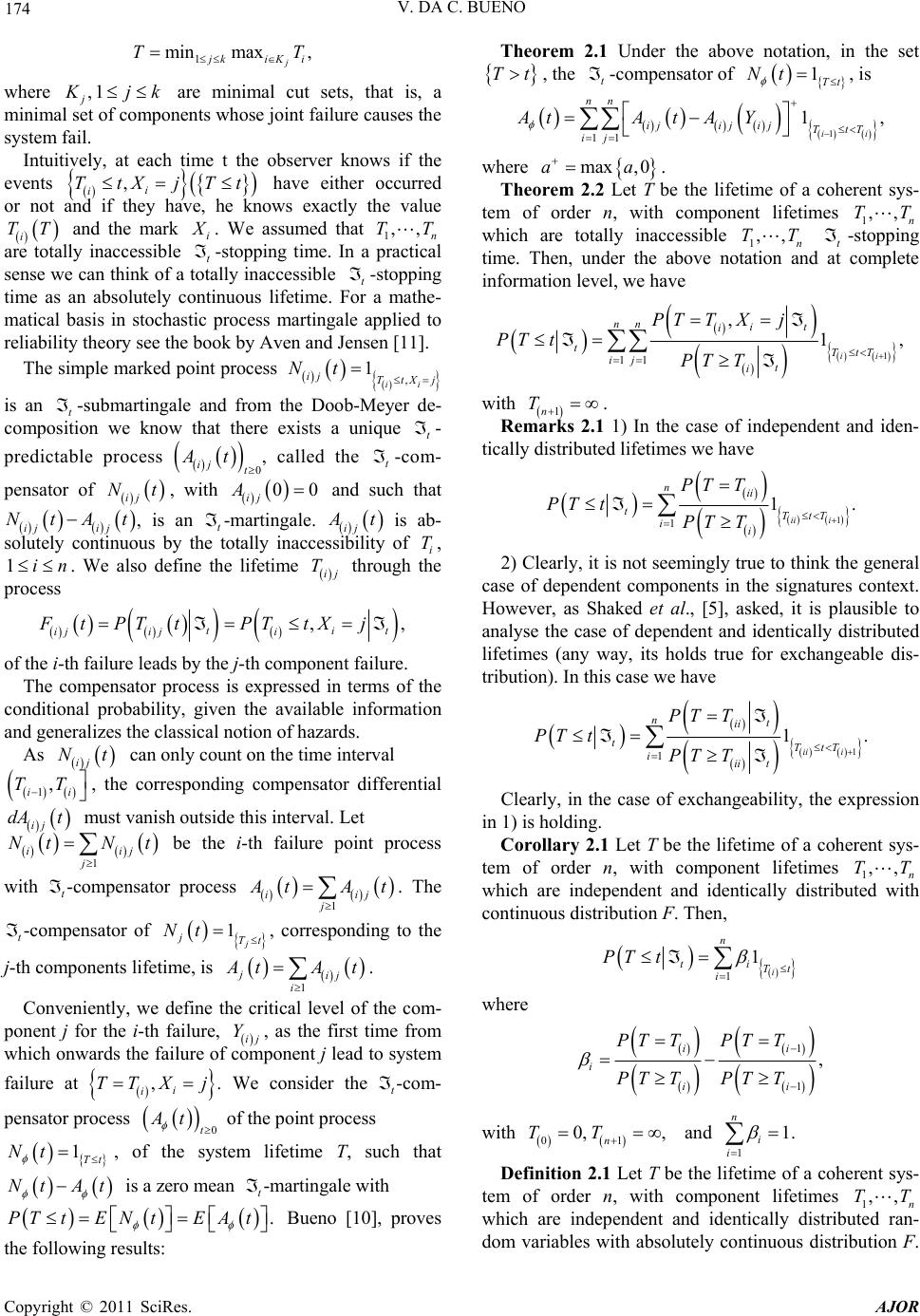 174 V. DA C. BUENO 1 min max, j j kiK TT i where ,1 j K jk are minimal cut sets, that is, a minimal set of components whose joint failure causes the system fail. Intuitively, at each time t the observer knows if the events have either occurred or not and if they have, he knows exactly the value i and the mark ,i i TtXjTt i TT X . We assumed that 1 are totally inaccessible t-stopping time. In a practical sense we can think of a totally inaccessible t-stopping time as an absolutely continuous lifetime. For a mathe- matical basis in stochastic process martingale applied to reliability theory see the book by Aven and Jensen [11]. ,, n TT The simple marked point pr ocess , 1i i ij TtXj Nt is an t-submartingale and from the Doob-Meyer de- composition we know that there exists a unique t - predictable process , called the 0 ij t At t -com- pensator of , with and such that ij N At t ij A 00 ijij , is an t -martingale. Nt ij A t is ab- solutely continuous by the totally inaccessibility of i, . We also define the lifetime through the process T 1in ij T , ti ij iji FtPTtPTtXj , t j of the i-th failure leads by the j-th component failure. The compensator process is expressed in terms of the conditional probability, given the available information and generalizes the classical notion of hazards. As can only count on the time interval ij Nt ,T 1ii T , the corresponding compensator differential ij dA t Nt must vanish outside this interval. Let 1 ii j N t t be the i-th failure point process with -compensator process 1 ii jj A tA j Tt 1 jij i t. The -compensator of , corresponding to the j-th components lifetime, is t 1 j Nt A tAt . Conveniently, we define the critical level of the com- ponent j for the i-th failure, ij , as the first time from which onwards the failure of component j lead to system Y failure at ,i i TTX j. We consider the t -com- pensator process 0t At of the point process 1Tt Nt Nt At , of the system lifetime T, such that is a zero mean t -martingale with t.NtE A PT tE Theorem 2.1 Under the above notation, in the set Tt, the t -compen sator of 1Tt Nt , is 1 11 1, ii ijij ijTtT ij AtAt A Y nn where max ,0aa . Theorem 2.2 Let T be the lifetime of a coherent sys- tem of order n, with component lifetimes 1 which are totally inaccessible 1 t-stopping time. Then, under the above notation and at complete information level, we have ,, n TT ,, n TT 1 11 ,1, ii nn it i tTtT ij t i PT TXj PT tPT T with 1n T . Remarks 2.1 1) In the case of independent and iden- tically distributed lifetimes we have 1 11. ii i nii tTtT ii PT T PT tPT T 2) Clearly, it is not seemingly true to think the general case of dependent components in the signatures context. However, as Shaked et al., [5], asked, it is plausible to analyse the case of dependent and identically distributed lifetimes (any way, its holds true for exchangeable dis- tribution). In this case we have 1 11. ii i nt ii tTtT it ii PT T PT tPT T Clearly, in the case of exchangeability, the expression in 1) is holding. Corollary 2.1 Let T be the lifetime of a coherent sys- tem of order n, with component lifetimes 1 which are independent and identically distributed with continuous distribution F. Then, ,, n TT 1 1i n ti Tt i PT t where 1 1 , ii i ii PT TPT T PT TPT T with 01 0, , n TT and 11. n i i Definition 2.1 Let T be the lifetime of a coherent sys- tem of order n, with component lifetimes 1 which are independent and identically distributed ran- dom variables with absolutely continuous distribution F. ,, n TT Bueno [10], proves the following results: Copyright © 2011 SciRes. AJOR 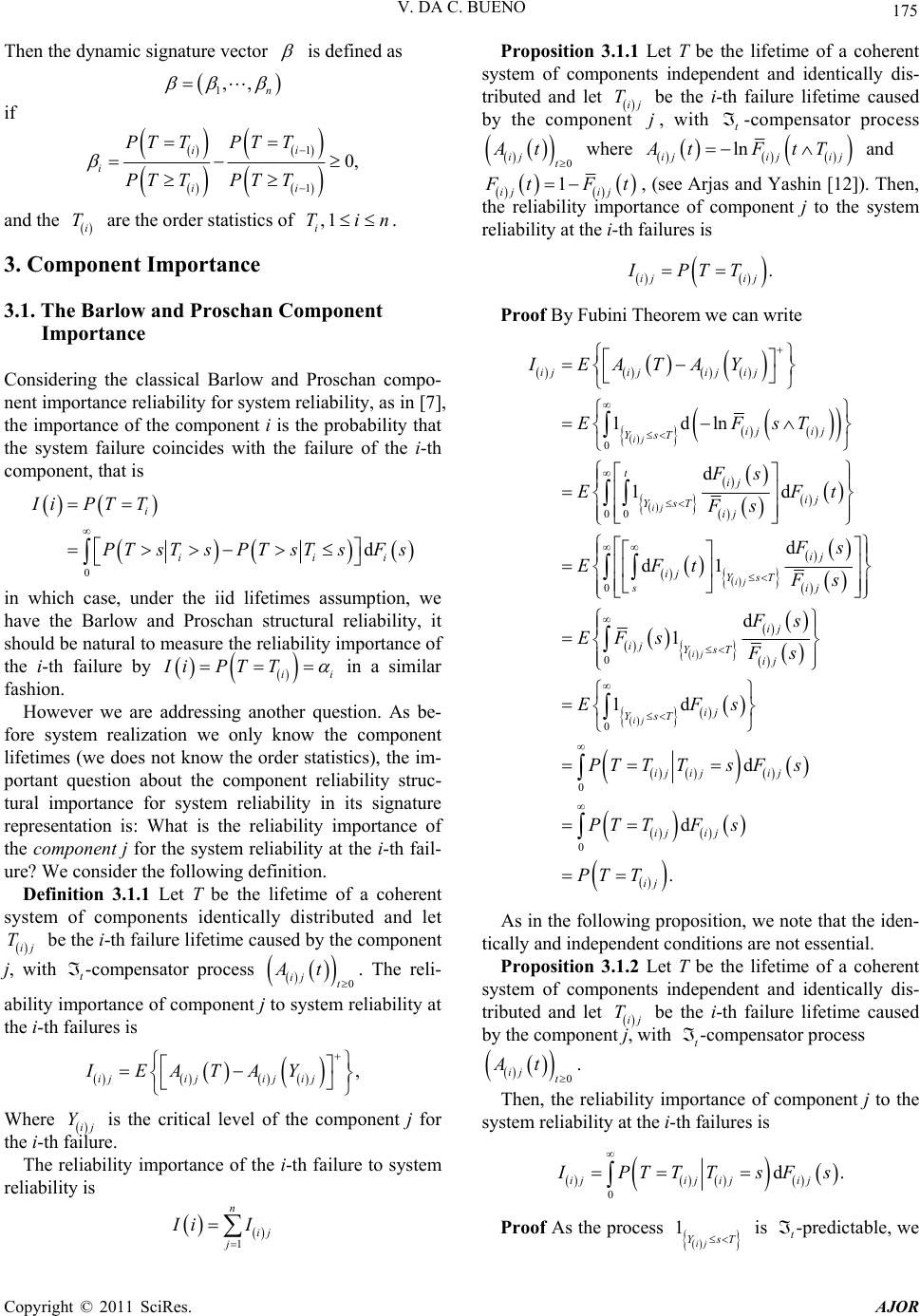 V. DA C. BUENO 175 Then the dynamic signature vector is defined as 1,, n if 1 1 0, ii ii T T i PT TPT PT TPT n and the are the order statistics of . i T,1 i Ti 3. Component Importance 3.1. The Barlow and Proschan Component Importance Considering the classical Barlow and Proschan compo- nent importance reliability for system reliability, as in [7], the importance of the component i is the probability that the system failure coincides with the failure of the i-th component, that is 0 d i iii IiPT T PTsTsPTTsF s s in which case, under the iid lifetimes assumption, we have the Barlow and Proschan structural reliability, it should be natural to measure the reliability importance of the i-th failure by i i IiPT T in a similar fashion. However we are addressing another question. As be- fore system realization we only know the component lifetimes (we does not know the order statistics), the im- portant question about the component reliability struc- tural importance for system reliability in its signature representation is: What is the reliability importance of the component j for the system reliability at the i-th fail- ure? We consider the following definition. Definition 3.1.1 Let T be the lifetime of a coherent system of components identically distributed and let be the i-th failure lifetime caused by the component ij T j, with -compensator process . The reli- t 0 ij t At ability importance of component j to system reliability at the i-th failures is , ijijij ij IEATAY Where ij is the critical level of the component j for the i-th failure. Y The reliability importance of the i-th failure to system reliability is 1 n ij j I iI Proposition 3.1.1 Let T be the lifetime of a coherent system of components independent and identically dis- tributed and let ij be the i-th failure lifetime caused by the component , with -compensator process Tjt 0 ij t At where ln ijij ij At FtT and 1 ij ij F tFt , (see Arjas and Yashin [12]). Then, the reliability importance of component j to the system reliability at the i-th failures is . ij ij IPTT Proof By Fubini Theorem we can write 0 00 0 0 1dln d 1d d d1 d 1 1 ij ij ij ij ijijij ij ij ij YsT tij ij YsTij ij ij YsT sij ij ij YsTij Y IEATAY EFsT Fs EF Fs Fs EFt Fs Fs EF sFs E t 0 0 0 d d d . ij ij sT ij ijij ij ij ij Fs PTTTs Fs PT TFs PT T As in the following proposition, we note that the iden- tically and independent conditions are not essential. Proposition 3.1.2 Let T be the lifetime of a coherent system of components independent and identically dis- tributed and let ij be the i-th failure lifetime caused by the component j, with T t -com pensator pro cess 0 ij t At . Then, the reliability importance of component j to the system reliability at the i-th failures is 0 d. ijij ijij I PTTTs Fs Proof As the process is -predictable, we 1ij YsT t Copyright © 2011 SciRes. AJOR 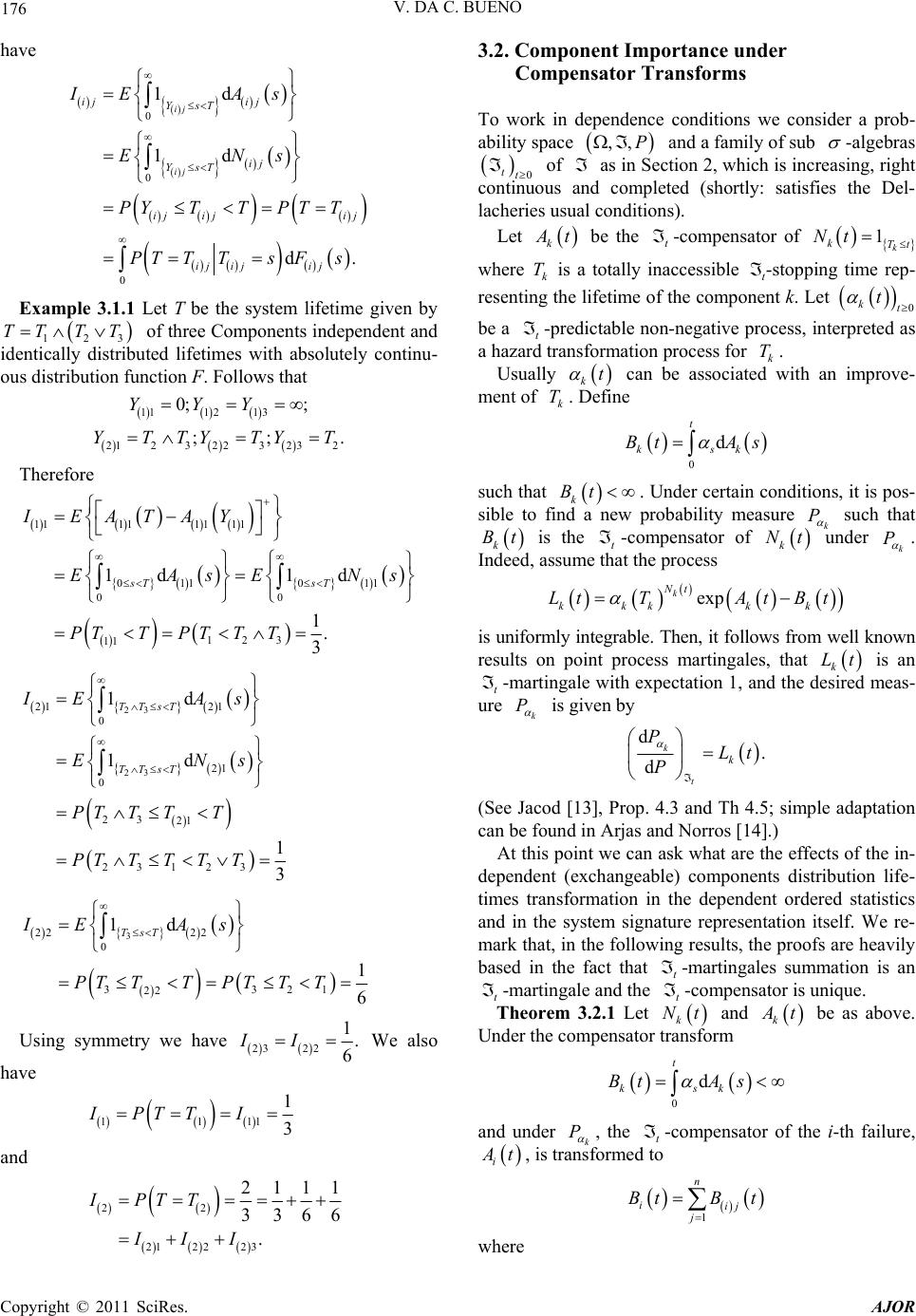 176 V. DA C. BUENO have 0 0 0 1d 1d d. ij ij ij ij YsT ij YsT ij ijij ij ijij IE As ENs PYTTPTT PTTTs Fs Example 3.1.1 Let T be the system lifetime given by of three Components independent and identically distributed lifetimes with absolutely continu- ous distribution function F. Follows that 123 TT TT . 1112 13 23 3 2 2122 23 0; ; ;; YYY YT TYTYT Therefore 111111 11 0110 11 00 123 11 1d 1d 1. 3 sT sT IEATAY EAsEN PTTPT TT s 23 23 21 21 0 21 0 23 21 23123 1d 1d 1 3 TTsT TTsT IE As EN PT T TT PT T TT T s 3 22 22 0 332 22 1d 1 6 TsT IE As PT TTPT TT 1 Using symmetry we have 23 22 1. 6 II We also have 111 1 3 IPTTI 1 and 22 21 2223 2111 3366 . IPTT III 3.2. Component Importance under Compensator Transforms To work in dependence conditions we consider a prob- ability space ,,P and a family of sub -algebras 0 tt of as in Section 2, which is increasing, right continuous and completed (shortly: satisfies the Del- lacheries usual conditions). Let k A t be the t -compensator of 1k kTt Nt where k T is a totally inaccessible t-stopping time rep- resenting the lifetime of the component k. Let 0 kt t be a t -predictable non-negative process, interpreted as a hazard transformation process for . k Usually T kt k can be associated with an improve- ment of . Define T 0 d t ksk Bt As such that k Bt . Under certain conditions, it is pos- sible to find a new probability measure k P such that k Bt is the t -compensator of under k N tk P . Indeed, assume that the proc ess exp k Nt kkk kk LtTAt Bt is uniformly integrable. Then, it follows from well known results on point process martingales, that k Lt is an t -martingale with expectation 1, and the desired meas- ure k P is given by d. dk t k PLt P (See Jacod [13], Prop. 4.3 and Th 4.5; simple adaptation can be found in Ar jas a n d N o rr os [1 4].) At this point we can ask what are the effects of the in- dependent (exchangeable) components distribution life- times transformation in the dependent ordered statistics and in the system signature representation itself. We re- mark that, in the following results, th e proofs are heavily based in the fact that t -martingales summation is an t -martingale and the t -compensator is unique. Theorem 3.2.1 Let ktN and k A t be as above. Under the compensator transform 0 d t ksk BtAs and under k P , the t -compensator of the i-th failure, i A t, is transformed to 1 n iij j BtB t where Copyright © 2011 SciRes. AJOR  V. DA C. BUENO 177 ij ij BtAt jk and 0 d t k ik ik Bt sAs . Proof We observe that the t -c 1 . ompensator of the i-th failure is set as 1 1 1 ii nn iijij TtT jj A tAtA t Also, the component -compensator can be set in the form: t 1 1 11 1 1 1. ii ii nn jij ij TtT ii n j TtT i A tAt A At t In the case of the k -compensator transform we have t 1 1 0 d d, l l Tt tn kkk kk lT lk lk Bt sAssAs sA s d . with , where 00T 1 1 ll k lk TsT s s Therefore, the effect of the k compensator trans- form in the compensator of the ith failure is through the i-th term of the last summation. 11 1 1 1d i ii i n iij j Tt n ijik ik TtTjk T BtBt Bt sAs Assuming that is uniformly integrable, k Lt 1 kk EL T and, under k P with d d k t k PLt P is the -compensator of t 1i Tt i Nt and the effect of the k compensator transform, in the compensator of the i-th failure is 0 d. t ikik ik Bt sAs Based in the Bergman [1] notion of reliability impor- tance and in Theorem 3.1.1, we can define. Definition 3.2.1 Let T and k be the system and the k-th component lifetimes respectively and let k TP be defined as above (assuming that is uniformly integrable). Suppose further that k is finite and T is integrable. Then the k Lt T k importance of Tk for T in i TT is , kkk ik IE ETOVTL COVTT , PP k T L i C where ij is the lifetime of the i-th failure caused by the j-th component failure. T T Examples 3.2.1 1) Consider the compensator change which arises from exactly one minimal repair of compo- nent k (Natvig [8]). Intuitively this means that when k occurs, the system is returned to the state in which it was immediately before k occurred. The second occur- rence of k is considered as final, and we take it as the improved value of k T. This improvement operation corresponds to the compensator transformation (Norros [15]) T T At 0 dln1. 1 tkkk k As As At As kk Bt In this case 1 k kk A s s A s t A ik exp Nt IC and therefore kk LT k kkk kkk TABt AT and, therefore, , k iik OVTT . 2) Bueno and Carmo [16] propose a parallel transform for the case of dependent components, through compen- sator transform as 22e 2e ln 0 xp d xp 2 ex. tk kk k kk Bt As At At p As As That is, we consider the transformations where 22 2e exp , xp k k k A s s As A 22exp kk kk LT T and ,2OVT2exp k ii IC AT ,1 i kik n . The case of deterministic compensators Under the assumptions that Ti are totally , Copyright © 2011 SciRes. AJOR 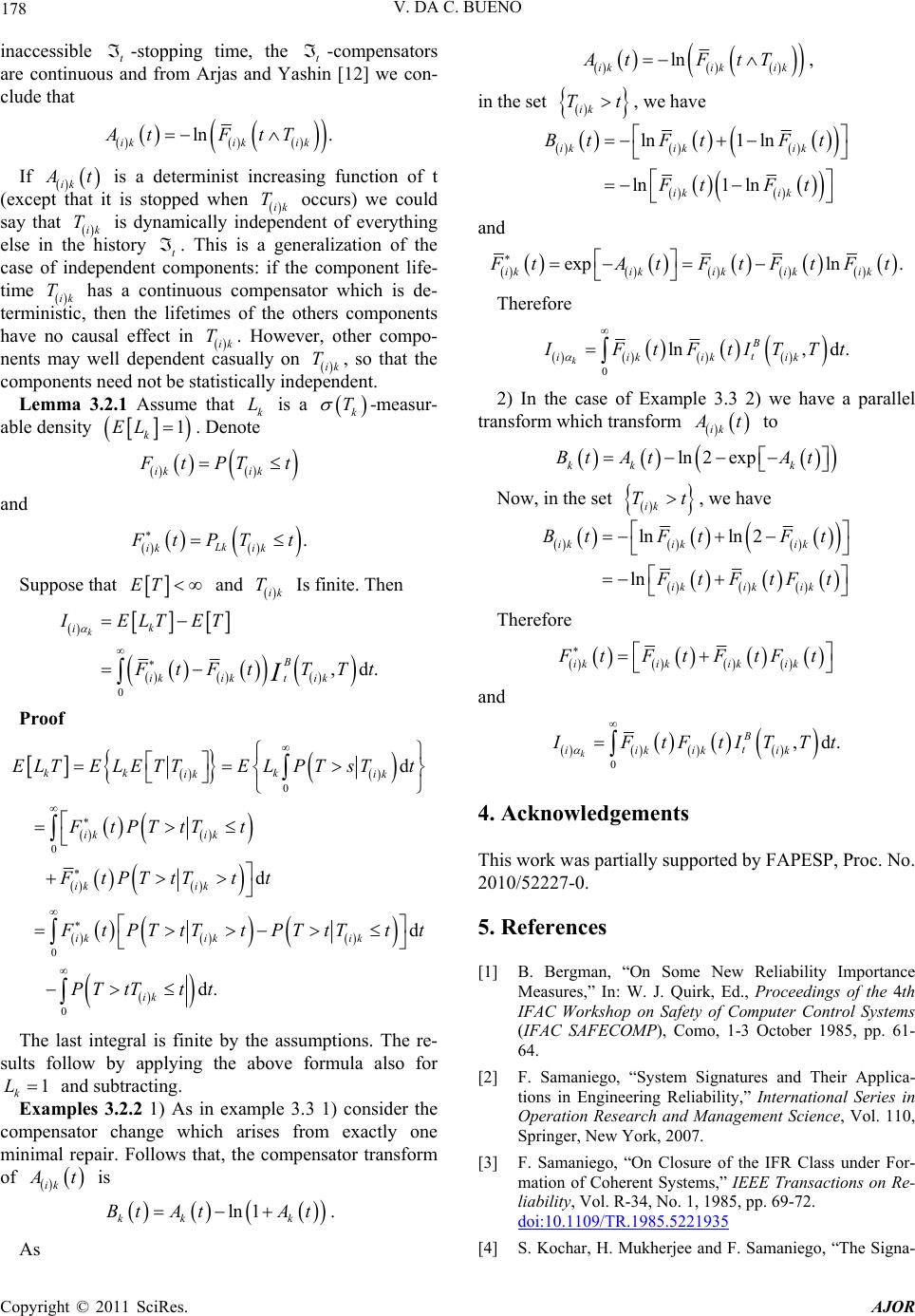 178 V. DA C. BUENO inaccessible t-stopping time, the t-compensators are continuous and from Arjas and Yashin [12] we con- clude that ik Tln . ik At Ft ik If ik A t T T is a determinist increasing function of t (except that it is stopped when ik occurs) we could say that ik is dynamically independent of everything else in the history t. This is a generalization of the case of independent components: if the component life- time ik has a continuous compensator which is de- terministic, then the lifetimes of the others components have no causal effect in ik. However, other compo- nents may well dependent casually on ik, so that the compone nt s n eed not be statis t i c al l y independent. T TT Lemma 3.2.1 Assume that k is a -measur- able density L k T 1 k EL . Denote ik ik F tPTt and . Lk ik ik F tPT t Suppose that ET and Is finite. Then ik T ik ,d. kk i B ikik t LTET 0 IE F tFt Tt I T Proof 0 0 0 0 d d d d. k ik ik ik ik ik ik ik ikik ik ELTETTELPTsTt PTtT t FtPTtTtt kk EL Ft F tP t TtTtPTtTtt PTTt t The last integral is finite by the assumptions. The re- sults follow by applying the above formula also for and subtracting. 1 k L Examples 3.2.2 1) As in example 3.3 1) consider the compensator change which arises from exactly one minimal repair. Follows that, the compensator transform of ik A t is ln 1 kk k t AtAtB. As ln ikik ik At FtT , in the set ik Tt, we have ln1 ln ln1 ln ik ikik ik ik Bt FtFt FtFt and expln . ikikik ikik F tAtFtFtF t Therefore 0 ln,d . k B t iikikik I FtFtITTt 2) In the case of Example 3.3 2) we have a parallel transform which transform ik A t to ln 2exp kk k Bt AtAt Now, in the set ik Tt, we have lnln 2 ln ik ikik ikik ik Bt FtFt F tFtFt Therefore ikikik ik F tFtFtFt and 0 ,d k B t iikik ik . I FtFtITTt 4. Acknowledgements This work was partially supported by FAPESP, Proc. No. 2010/52227-0. 5. References [1] B. Bergman, “On Some New Reliability Importance Measures,” In: W. J. Quirk, Ed., Proceedings of the 4th IFAC Workshop on Safety of Computer Control Systems (IFAC SAFECOMP), Como, 1-3 October 1985, pp. 61- 64. [2] F. Samaniego, “System Signatures and Their Applica- tions in Engineering Reliability,” International Series in Operation Research and Management Science, Vol. 110, Springer, New York, 2007. [3] F. Samaniego, “On Closure of the IFR Class under For- mation of Coherent Systems,” IEEE Transactions on Re- liability, Vol. R-34, No. 1, 1985, pp. 69-72. doi:10.1109/TR.1985.5221935 [4] S. Kochar, H. Mukherjee and F. Samaniego, “The Signa- Copyright © 2011 SciRes. AJOR  V. DA C. BUENO Copyright © 2011 SciRes. AJOR 179 ture of a Coherent System and Its Application to Com- parisons among Systems,” Naval Research Logistic, Vol. 46, No. 5, 1999, pp. 507-523. doi:10.1002/(SICI)1520-6750(199908)46:5<507::AID-N AV4>3.0.CO;2-D [5] M. Shaked and A. Suarez-Llorens, “On the Comparison of Reliability Experiments Based on the Convolution Order,” Journal of American Statistical Association, Vol. 98, No. 4, 2003, pp. 693-702. doi:10.1198/016214503000000602 [6] Z. W. Birnbaum, “On the Importance of Different Com- ponents in a Multicomponent System,” In: P. R. Krish- naiah, Ed., Multivariate Analysis, Academic Press, New York, 1969, pp. 591-592. [7] R. Barlow and F. Proschan, “Importance of Systems Components and Fault Trees Events,” Stochastic Proc- esses and Their Applications, Vol. 3, No. 2, 1975, pp. 153-173. [8] B. Natvig, “New Light on Measure of Importance of Systems Components,” Scandinavian Journal of Statis- tics, Vol. 12, No. 1, 1985, pp. 43-54. [9] P. J. Boland and E. El-Neweihi, “Measures of Compo- nent Importance in Reliability Theory,” Technical Report, Florida State University, Tallahassee, 1990. [10] V. C. Bueno, “Dynamics Signature of a Coherent Sys- tem,” Technical report, São Paulo University, São Paulo, 2010. [11] T. Aven and U. Jensen, “Stochastic Models in Reliabil- ity,” Springer Verlag, New York, 1999. doi:10.1198/016214503000000602 [12] E. Arjas and A. Yashin, “A Note on Random Intensities and Conditional Survival Functions,” Journal of Applied Probability, Vol. 25, No. 3, 1988, pp. 630-635. doi:10.1198/016214503000000602 [13] J. Jacod, “Multivariate Point Processes: Predictable Pro- jection. Radon-Nikodyn Derivatives, Representation of Martingales,” Zeitschrift fur Wahrscheinlichkeitstheorie und Verwandte Gebiete, Vol. 31, 1975, pp. 235-253. doi:10.1007/BF00536010 [14] E. Arjas and I. Norros, “Change of Life Distribution via a Hazard Transformation: An Inequality with Application to Minimal Repair,” Mathematics of Operations Research, Vol. 14, No. 2, 1989, pp. 355-361. [15] I. Norros, “Notes on Natvig’s Measure of Importance of Systems Components,” Scandinavian Journal of Statis- tics, Vol. 12, 1986, pp. 43-54. [16] V. C. Bueno and I. M. Carmo, “Active Redundancy Al- location for a k-out-of-n:F System of Dependent Com- ponents,” European Journal of Operational Research, Vol. 176, No. 2, 2007, pp. 1041-1051. doi:10.1016/j.ejor.2005.09.012 |

